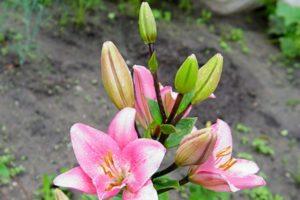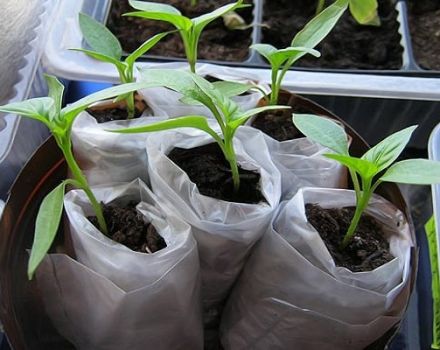Do I need to dig lilies for the winter, preparing a shelter, when to cut and how to store
Many summer residents grow lilies in their gardens or flower beds to decorate their summer cottage. These are beautiful flowers that bloom in the first half of summer and bloom for 30-40 days. Before planting such flowers, you need to figure out whether you need to dig up lilies for the winter.
Do I need to dig up lilies for the winter?
It is rather difficult to unequivocally answer this question, since everything depends on the characteristics of the climate in which the plant is grown. For example, if the winter is warm enough in the region, then it is not necessary to dig up flowers. However, despite this, before wintering, you will have to dig up the plant in order to get rid of the weakened old bulbs that will definitely not be able to winter.
You should also consider the variety of lilies that are planted in the garden. Some varieties of flowers do not need cutting, as they are resistant to temperature extremes and frost. Such plants include varieties bred in Asia. Oriental hybrid flower types do not tolerate nighttime temperature drops and may not survive the winter cold.
In early September, they are dug up, transplanted into pots and left until spring in rooms with a temperature of 5-10 degrees.
Preparing a shelter for the winter
It is recommended to prepare a place where the flowers will be stored before digging up. It must meet the following requirements:
- Moderate humidity. The dug plant should not be stored in high humidity conditions, as it will deteriorate and begin to germinate.
- The temperature is above freezing. The shelter should be relatively warm so that the temperature does not drop below zero degrees.
- High quality ventilation. The plant needs air, and therefore there should be normal air exchange in the shelter.
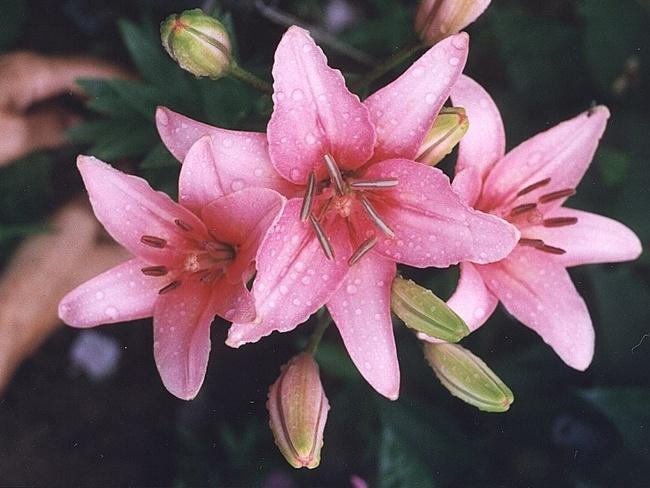
Cropping flowers
Autumn pruning of inflorescences is carried out before digging. Cut them off very carefully so as not to accidentally damage the plant. Experts advise using a sharp blade or garden shears.
Terms and features of digging
Digging time depends on the variety grown, as some of them can be harvested in late autumn. Most often, gardeners remove lilies from the beds immediately after flowering - in late August or early September. It is very important that the digging is done after the leaves of the plant turn yellow. Yellowness on the leaves indicates that all the useful components have passed into the bulbs, and the plant is ready for winter.

When digging up lilies, do not use a shovel, as it can damage the root system. Better to use a pitchfork, which is easier to dig into the onion. They burrow into the ground to a depth of 7-8 centimeters, after which the flower is buried in and carefully removed from the ground.
What to do with dug up bulbs?
Inexperienced gardeners do not know what to do with flowers in winter and how to properly care for them.
Cold storage
Most often, the dug up bulbs are stored in conventional refrigerators. Before you put them there, you need to familiarize yourself with the features of this storage method. To preserve the plant, its bulbs are placed in plastic bags filled with moistened peat. Only then can they be placed in the refrigerator.
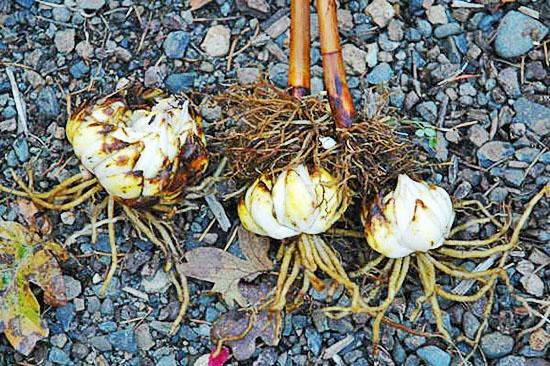
The main advantages of this method include the ability to control the temperature, thanks to which the bulbs will not deteriorate until spring.
In a cellar or basement
Residents of private houses and summer cottages prefer to store flower bulbs in basements or cellars. In such rooms, at any time of the year, a low above zero temperature remains, which contributes to the preservation of bulbs before planting in spring. However, if the cellar is too old, the temperature can drop below freezing in winter. Therefore, before storing lilies in the basement, you need to make sure that it is reliable.
In flower pots
There are situations when, when storing bulbs at home, they begin to germinate. In this case, you will have to immediately plant them in pots with soil mixture. If this is not done, the seed will deteriorate and be unusable for planting in the spring.
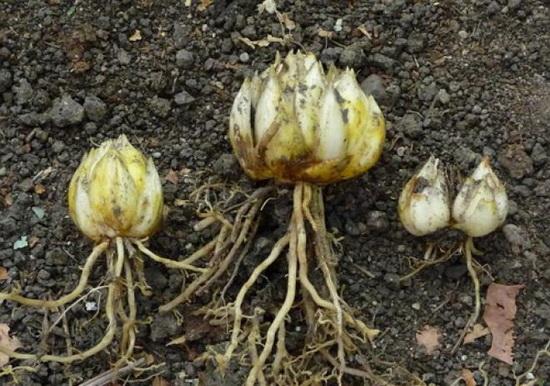
Can bulbs be left in the ground?
Some growers are afraid to dig up lilies and leave them in the open field. This is quite dangerous, especially if the flowers are grown in northern regions with harsh winters. However, experienced gardeners assure that bulbs hibernate normally and do not deteriorate under a dense snow cover.
It is necessary that the snow shelter be at least fifteen centimeters thick.
If there is no snow cover, the probability that the plant will die is extremely high. Therefore, for safety reasons, the area where the flowers are grown is covered with an insulating layer of coniferous paws, dry spruce twigs and peat. When creating an insulating shelter, it is spruce and coniferous branches that are used, since they are the most reliable. The shelter is removed in the spring when the frost ends and the temperature rises to 5-7 degrees.
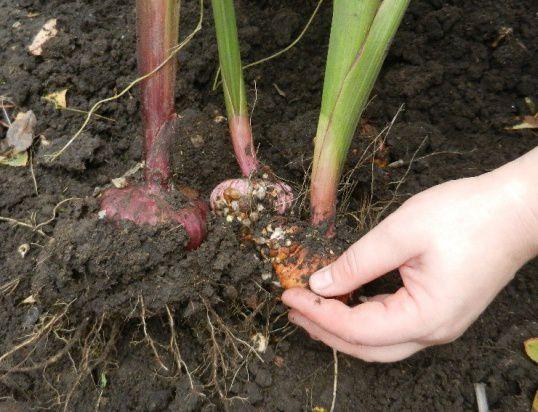
People who plan to leave bulbs in the ground for the winter should remember that this method is used only when growing frost-resistant varieties. This storage method is not suitable for oriental hybrids, since they will die during the first frost. Even the extra polyethylene coating will not keep hybrid varieties from cold temperatures.
Mistakes in caring for lilies in autumn and in preparation for winter
Some growers do not properly care for lilies during preparation for wintering. There are a few of the most common mistakes you should be aware of:
- Watering. People who grow flowers often water them even in the fall. However, experienced gardeners are advised to stop moistening the soil with lilies 2-3 weeks before digging. If this is not done, the dug up bulbs will absorb moisture and germinate in winter.
- Incorrect feeding. Sometimes gardeners stop feeding lilies together with watering. Because of this, the bulbs do not have time to stock up on nutrients for the winter and die even after digging up. To prevent this from happening, in the fall, mineral dressings are added to the soil in the form of mixtures of superphosphate and potassium. When carrying out fertilizing per square meter, 10-12 liters of fertilizing liquid are consumed.
- Premature pruning of flowers.Often people who first started growing lilies do not cut flowers on time, which leads to their death. Pruning is carried out only after the inflorescences have faded and began to fade.
- Digging up the bulbs later. The most serious mistake that leads to the death of flowers.
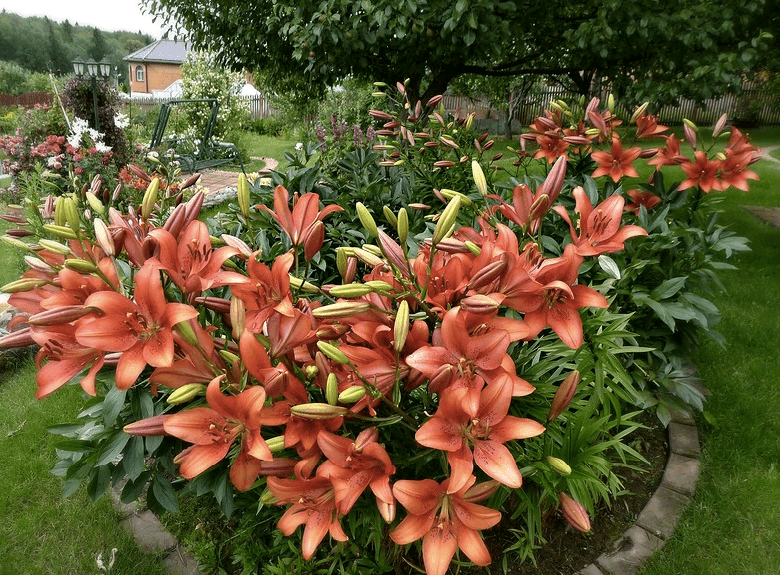
Reproduction during storage
Winter is considered the most suitable time for lilies to breed. When performing this procedure, use the scales of the onions. The breeding process is carried out in several stages:
- Flake preparation. First, they are engaged in preparatory work, during which all the scales are separated from the bulbs. This is done very carefully so as not to damage anything. You can separate them both manually and using a sharp blade.
- Soaking. The detached flakes are soaked in a fungicidal solution or in a manganese liquid. In this case, they should be soaked for about 40-45 minutes.
- Drying and storage. All soaked flakes are washed with water, dried and placed in a container filled with peat. After a month and a half, adult bulbs will sprout from them, which can be planted in a flower bed in spring.
- Planting. Before planting young bulbs, they are carefully removed from the pot of peat. Then they are placed in the dug holes and watered with water.
Conclusion
Lilies are common flowers that are popular with flower growers. People who want to plant them for the first time on their site should understand the timing of digging up lilies before the beginning of winter, as well as the peculiarities of their storage, reproduction and planting in spring.
